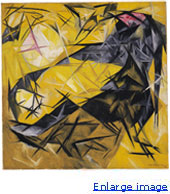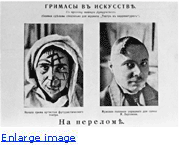
|
 |
 |

|







Order the catalogue |
 |
  Goncharova manifested her radicality in
both life and art. She shocked the Moscow bourgeoisie with
her casual cross-dressing and her open cohabitation with
artist Mikhail Larionov, and elicited the anger of the
righteous with her brazen interpretations of religious
subjects such as The Evangelists (in Four Parts),
1911. Not unexpectedly, she was the victim of hostility and
disparagement in the press, and the official censor forced
her paintings to be withdrawn from more than one
exhibition. Goncharova manifested her radicality in
both life and art. She shocked the Moscow bourgeoisie with
her casual cross-dressing and her open cohabitation with
artist Mikhail Larionov, and elicited the anger of the
righteous with her brazen interpretations of religious
subjects such as The Evangelists (in Four Parts),
1911. Not unexpectedly, she was the victim of hostility and
disparagement in the press, and the official censor forced
her paintings to be withdrawn from more than one
exhibition. |
 |
 |
  Goncharova's vivid paintings of industrial
machinery, the local countryside, and peasants and pagan
effigies (including Sabbath, 1912, and The
Evangelists), demonstrate the breadth of her subject
matter and the richness of her vision. While she was aware
of French painting after Impressionism, especially the work
of Paul Gauguin and Henri Matisse, Goncharova derived true
inspiration from the indigenous traditions of medievel
Russian art. In the Russian icon, for example, she
discovered new perceptions of space, anatomical proportion,
and color combinations, which she then applied to her own
studio paintings, book illustrations, and stage designs.
She also looked at peasant embroidery, the lubok
(hand-colored print), and even the stone baba or
stellae, examples of which dotted the Russian and Ukrainian
landscape. Peasants Gathering Grapes, 1912, is a
convincing paraphrase of this particular ethnographic
concern. Goncharova's vivid paintings of industrial
machinery, the local countryside, and peasants and pagan
effigies (including Sabbath, 1912, and The
Evangelists), demonstrate the breadth of her subject
matter and the richness of her vision. While she was aware
of French painting after Impressionism, especially the work
of Paul Gauguin and Henri Matisse, Goncharova derived true
inspiration from the indigenous traditions of medievel
Russian art. In the Russian icon, for example, she
discovered new perceptions of space, anatomical proportion,
and color combinations, which she then applied to her own
studio paintings, book illustrations, and stage designs.
She also looked at peasant embroidery, the lubok
(hand-colored print), and even the stone baba or
stellae, examples of which dotted the Russian and Ukrainian
landscape. Peasants Gathering Grapes, 1912, is a
convincing paraphrase of this particular ethnographic
concern.
|
 Top right: Cats (rayist percep.[tion]
in rose, black, and yellow), 1913. Oil on canvas, 84.5
x 83.8 cm. Solomon R. Guggenheim Museum, New York 57.1484.
© 2000 Artists Rights Society (ARS), New York/ADAGP,
Paris. Top right: Cats (rayist percep.[tion]
in rose, black, and yellow), 1913. Oil on canvas, 84.5
x 83.8 cm. Solomon R. Guggenheim Museum, New York 57.1484.
© 2000 Artists Rights Society (ARS), New York/ADAGP,
Paris.
|
Above: Photograph of Goncharova and
Mikhail Larionov made up for a Furturist theater project,
1913. Reproduced in Teatr v karrikaturakh (Moscow),
no. 3 (Sept. 21, 1913), p. 9.
|























